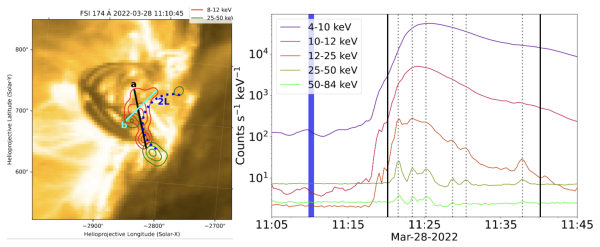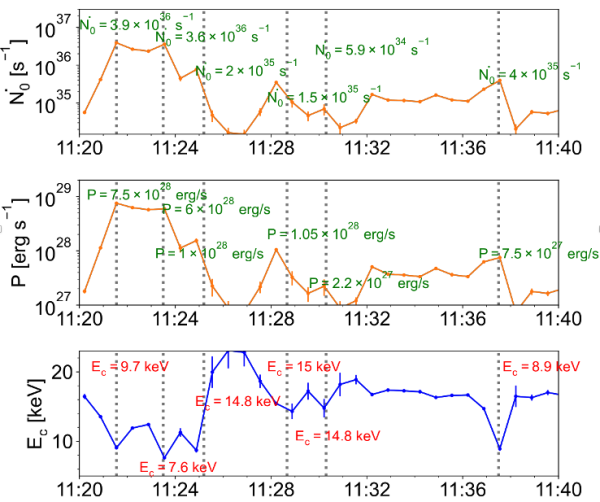Time evolution of flare-accelerated electrons in the warm-target model
| Nugget | |
|---|---|
| Number: | 506 |
| 1st Author: | Debesh BHATTACHARJEE, |
| 2nd Author: | Eduard KONTAR and Yinjie LUO |
| Published: | October 6, 2025 |
| Next Nugget: | TBD |
| Previous Nugget: | SOLSTICE observes flare Doppler shifts in Si III |
Introduction
Solar flares are localized explosions in the lower atmosphere of the Sun over a time scale of several tens of minutes, deriving their energy from twisted magnetic fields of the solar corona. The effects - which can be of energy up to 1033 erg - appear in a wide range of electromagnetic wavelengths from radio to gamma waves. A substantial part of this released energy can go into accelerating the electrons present in the flare loop. These flare-accelerated electrons then propagate through the plasma and (via the bremsstrahlung process) produce X-rays of a wide range of energies. The high-energy electrons can enter the chromospheric foot points of the flare and produce high energy X-rays or hard X-rays (HXR), while the lower-energy electrons would remain more or less distributed in the coronal loop top region producing low-energy X-rays or soft X-rays (SXR). The X-radiation is our central way to observe the flare-accelerated electrons, and we have imaging spectroscopic data from spaceborne observatories such as RHESSI and Solar Orbiter (STIX) understand the physics of flare-accelerated electrons via their X-radiation.
The "warm-target" model
In this study we apply the warm-target theoretical model (Ref. [1]), which describes the behavior of accelerated and trapped electrons self-consistently. the observational data to probe this temporal evolution. Unlike the commonly used cold-target model, the warm-target model accurately estimates the low-energy cut-off (Ec) of the nonthermal electron distribution function. This is crucial for accurate estimation of total nonthermal power and flare energy. The warm target model also describes the excess emission measure (EM) due to the thermalization of accelerated electrons. EM is defined by the flux S = EM x f(T), where f(T) represents the spectral distribution; for a thermal source it is the product of the particle densities ne<\sub>ni<\sub> for electrons and ions.
Modeling SOL2022-03-28
This beautiful flare erupted at the E limb of the Sun as seen by Solar Orbiter (Figure 1).

We have studied this flare (and two other representative ones, in Ref. [2]) to address three questions:
1. How does the Ec evolve as the flare progresses in time? 2. How does the flare energy release evolve with time? 3. How does the EM evolve with time (ΔEM), compared with the initial EM?
Using the image in Figure 1, we estimate the flare loop length (the dotted blue arc) and the coronal source volume (the region marked by lines a and b. For the analysis, we also need the light curve of the flare (see right panel of Figure 1). The region between the two black vertical lines are the region of interest, while the heavy blue line defines a background interval. The six dotted grey vertical lines represent six HXR peaks of this flare. We have found that the total rate (N0) of flare-accelerated electrons has maxima corresponding to these peaks (top panel of Figure 2), while the temporal profile of P resembles the time evolutioon of N0 (middle panel of Figure 2). The time profile of Ec shows an opposite trend: a high-low-high feature around the HXR peaks (bottom panel of Figure 2).
Conclusion
Our study shows that there is a higher rate of softer (lower energy; low Ec) accelerated electrons around the HXR peaks of a flare, implying an increase of acceleration efficiency around the HXR peaks. Our findings also suggest that the time profile of power P is mostly governed by the time evolution of N0. Finally, we also have also found (but not shown in this Nugget) that the excess emission measure ΔEM, relative to the total emission measure, EM, shows its maximum contribution (approximately 33%) around the first HXR peak of a flare. These findings are true for other two studied flares as well. This therefore suggests that around the first HXR peak of a flare, highest number of nonthermal electrons are getting thermalized. The warm-target analysis thus can provide new insights into the problematic electron acceleration mechanism in flares.
